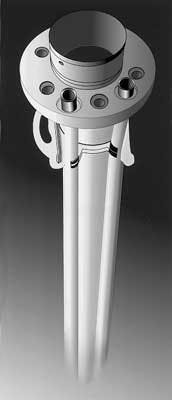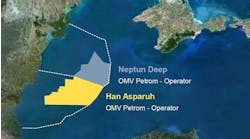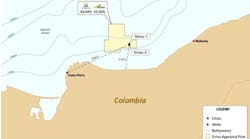Duplex stainless steels from Sandvik are generating weight and costs savings for drilling riser manufacturers. This is due to the higher tensile and yield strengths of the SAF 2205 and SAF 2507 grades compared with standard 316L stainless steels.
Drilling risers comprise a heavy gauge, large diameter carbon steel center tube through which the drillstring is lowered to the seabed. Hydraulic tubes, which surround and are secured to the central riser tube have outside diameters that normally vary 38-127 mm. The function of these tubes is to control valves and other functions. They often operate at pressures of 300 bar or more.
Schematic shows how smaller hydraulic tubes are wrapped around a central carbon steel tube to make up a drilling riser.
The strength benefits of duplex over standard stainless steels means that a much thinner wall thickness can be applied to the hydraulic tubes for the same pressure, resulting in weight savings. For example, a 316L hydraulic tube with an OD of 2 7/8-in., operating at 250 bar, would need a wall thickness of 0.376-in. This thickness can be reduced to 0.22-in. using SAF 2205 in a similar application, and 0.173 using SAF 2507, leading to potential weight savings approaching 50%.
Admittedly, high strength steels cost more per kg. However, the cost per meter of tubing is offset by the reduced wall thickness. The lighter tubes also reduce the cost of the added buoyancy requirement (typically, each 20-30 meter section of riser is fitted with a flotation collar). Riser weight is becoming an increasingly critical issue as drilling functions take place in greater water depths.
Small bore tubing
Recently, Sandvik also introduced a new integrated fluid-bearing tubing system incorporating SAF 2507 super duplex stainless steel, in association with Swagelok. The joint development started three years ago, following requests from oil companies for small-bore tubing systems capable of withstanding highly corrosive, chloride-containing environments encountered during deepwater programs.
At the time, they were dependent on duplex austenitic/ferritic alloys. The new solution, based on the SAF 2507 alloy, "offers easier installation, better corrosion resistance and lower weight than conventional solutions," says Sandvik's Magnus Nystrom.
For more information, contact Lars Ostlund, Sandvik Steel. Tel: +46 26 260000, Fax: +46 26 264265, E-mail: [email protected]




